The task:
Replace old-fashioned emptying containers with modern big bag emptying stations
With additional protective screening, consistently emission-free and no need for conversion measures at the installation site.
In order to feed the milk powder, delivered in big bags to production, our customer previously relied on a simple solution, which, however, also had weak points:
The big bag filled with lactose was picked up by a crane track and brought into position above the emptying container. Then, the operator connected the discharge spout of the big bag and the inlet of the emptying container and emptied the milk powder directly into the container. The connection created between the big bag and the discharge container was very dusty.
Previous weaknesses:
- When the milk powder is emptied directly into the discharge container, particles of the product also escape into the plant environment with the displaced air. Personnel and production equipment are thus exposed to a high dust load.
- Due to its high fat content, lactose also tends to bridge when emptied from big bags. Without additional mechanical action from the outside, it is difficult for the product to flow out of the big bag.
- With the previous solution, the operator knocks on the outside of the big bags to break up the material bridges during emptying. This requires a great deal of force, poses risks of injury, is time-consuming and inconvenient. In addition, the big bag can be damaged, resulting in additional dust leakage.
- Another problem is that product residues remain in the big bags. They get stuck in the folds of the big bag and complicate disposal. When the empty big bag is removed and folded, particles escape from the big bag outlet and additionally contaminate the operator and the production environment.
- If a big bag is to be only partially emptied and then closed again, the previous solution reaches its limits.
- There was also potential for improvement with regard to the transfer to the further production process, e.g. by integrating an additional protective screening. Without protective screening, any foreign bodies are only separated at a later stage in the production process. By then, however, they have already come into contact with the sensitive production equipment. This can already be enough to cause contamination.
- Further challenge: The space available at the installation site was limited. The old discharge containers were more narrow than those used in today’s emptying stations. They were lined up close together, directly above the respective conveying unit. Nothing was allowed to be changed in the position of these conveying elements. The Engelsmann designers planned the new big bag stations to fit so precisely that existing connections could continue to be used and costly conversion measures were not necessary.
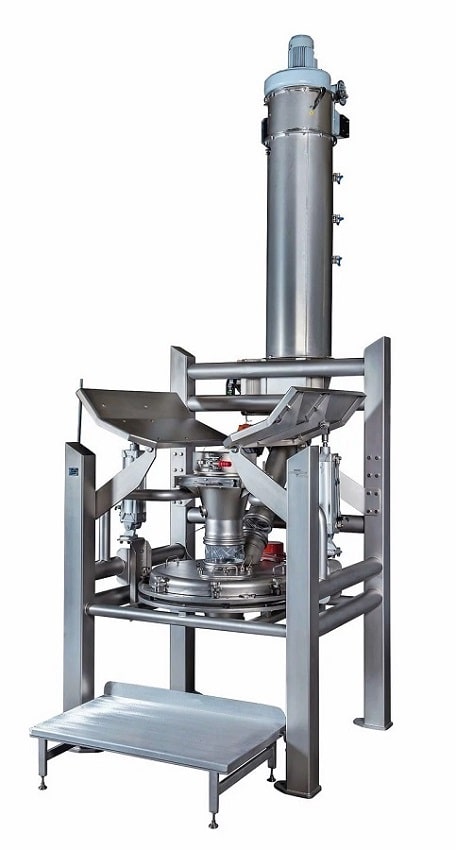
Big Bag emptying station for lactose from Engelsmann: with integrated protective sieving and dedusting system.
The aged discharge vessels were replaced by modern discharge stations from Engelsmann. Equipped with integrated protective screening and modern dedusting system.
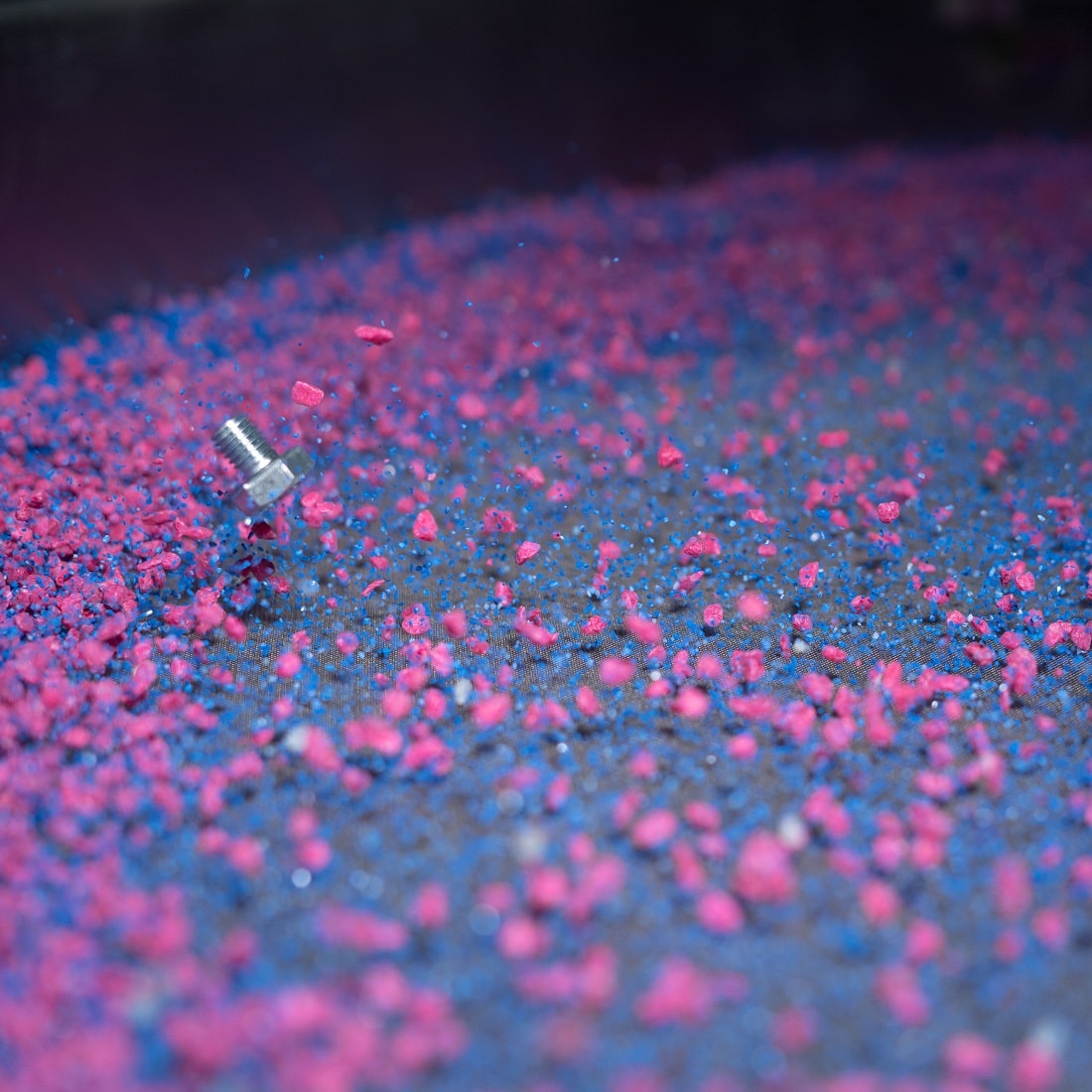
Protective screens provide safety. Used during raw material feeding, they separate foreign bodies and impurities before they enter the production process. However, the integration of a further process step always means additional space requirements. It is therefore important that the screening machine used is designed to save space. Like the JEL Fix II protective screen from Engelsmann, which can be optimally integrated even into existing plants – thanks to its particularly low overall height. And of course we also equip new plants with it – like these big bag emptying stations for lactose.
Precise fit – many functions:
Space-saving Big Bag station with emptying aid, protective screening and dust removal.
Individually planned on 2.5 m² floor space per emptying station.
Standard solutions quickly reach their limits in such cases. It has advantages, if components can be flexibly combined to a big bag emptying system. Or even individually manufactured and thus even better adapted to the customer’s needs, as in this project.
The basic frame of the new emptying solution is open at the top so that the operator can continue to feed the big bags via his on-site crane track. In order to ensure fast and complete emptying of milk powder containing fat, emptying aids – here in the form of a walker paddles – are used.
The walker paddles consists of two support cheeks on which the full big bag is placed. The paddles are alternately lifted pneumatically and raise the big bag on one side at a time. Product bridges are thus broken up and the entire content of the big bag is emptied quickly and efficiently thanks to the modified angle of repose.
In addition to their function as emptying aids, walkers also function as fall protection for the big bags, thus ensuring operator protection.
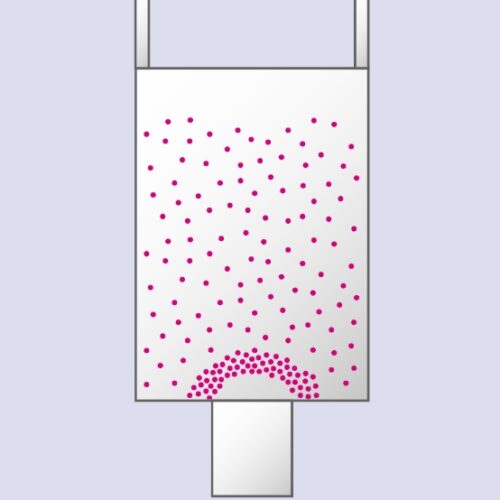
Bridging: compacting materials form a bridge over the outlet, preventing the product from being discharged from the big bag.
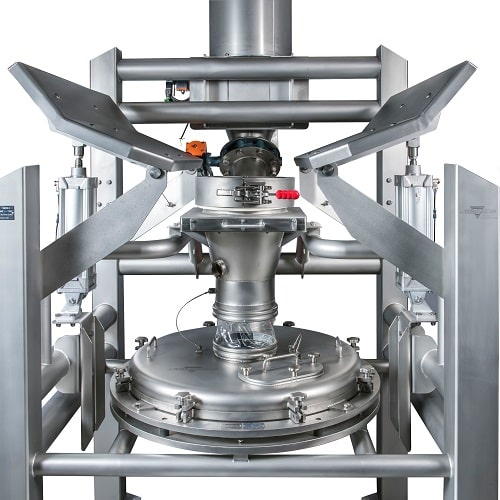
The pneumatically controlled support cheeks of the walker device release product bridges and ensure efficient discharge of the lactose.
Since the operator currently uses big bags with a very short outlet, but can vary the length in the future, the walker paddles were designed to be height-adjustable. In the case of a longer outlet, the walker paddles can be adjusted upward so that the full surface of the big bag rests on them. The Big Bag can still be reached conveniently via an operating platform.
Due to the tight space conditions on site, the new emptying aids are also a special design in terms of their dimensions: cranked support cheeks fit into the narrowly cut emptying station and allow the operator convenient access to the big bag.
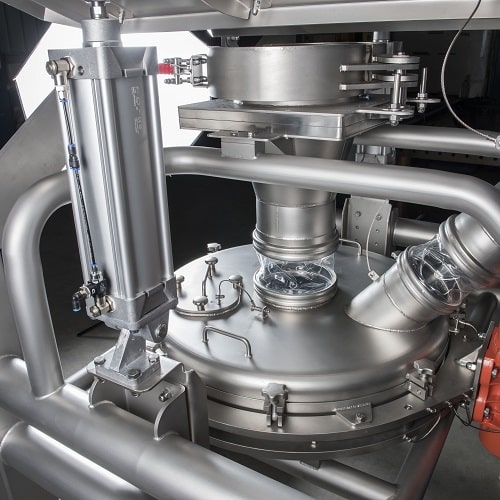
The height-adjustable walker paddles enable the use of different big bag formats.
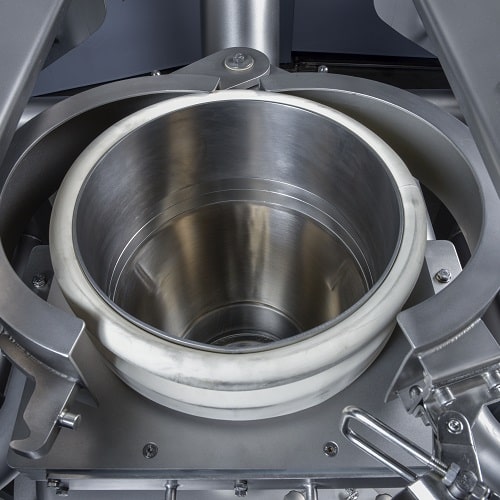
Uncomplicated, flexible and dust-tight: connecting the big bags with inflatable sleeves and hinged trays.
For a dust-free emptying process, the connection spout is equipped with an inflation collar. After the big bag outlet has been slipped over the sleeve and the hinged trays have been closed, the inflatable sleeve is actuated pneumatically. It inflates and presses the big bag outlet firmly against the hinged trays so that any dust can no longer escape into the production environment.
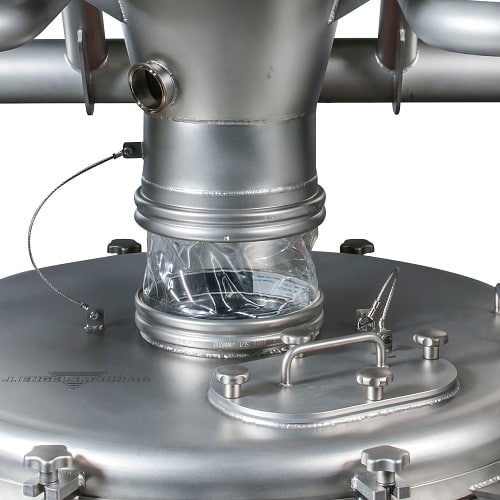
Possibility to take samples directly at the discharge hopper.
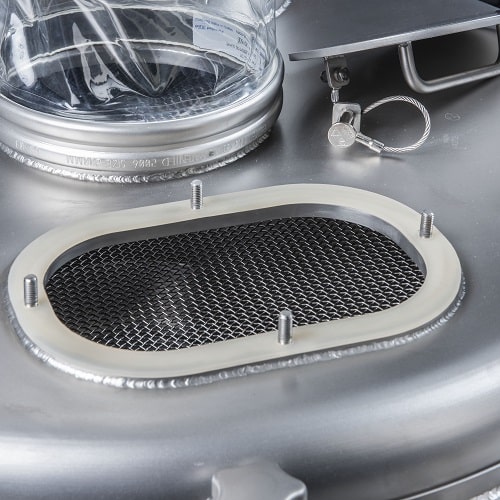
Inspection window for checking the sieve mesh.
An important requirement for the operator was to be able to randomly check the product quality of the milk powder delivered. For this purpose, the discharge hoppers located below the connection spout are each equipped with a connecting piece for the connection of samplers. The operator can thus take the product samples from the running product stream during emptying. The emptying unit is additionally equipped with emergency slides with which the product flow can be interrupted at any time, for example in the case of a tear in the screen mesh.
JEL Fix II
Integrated protective sieving with filter system
Thanks to its flat design, the JEL Fix II vibrating sieve is particularly well suited for installation in existing plants.
Via the discharge hopper and BFM sleeves connected to it, the milk powder flows into a vibrating screen. In this case, the sieve inserts are covered with a relatively coarse mesh size of 4 mm. Since a standing column of product can form on the sieve mesh when lactose is discharged, the protective sieve is designed to be both gas-tight and dust-tight.
A special feature of this screening solution is the easy disassembly without tools. This is mainly due to the plug-in groundings (the installation site is an ATEX protection zone) as well as the easily removable BFM sleeves connecting the control screen to the respective discharge hopper. If these connections are loosened, the sieve cover can be removed upwards in a few easy steps.
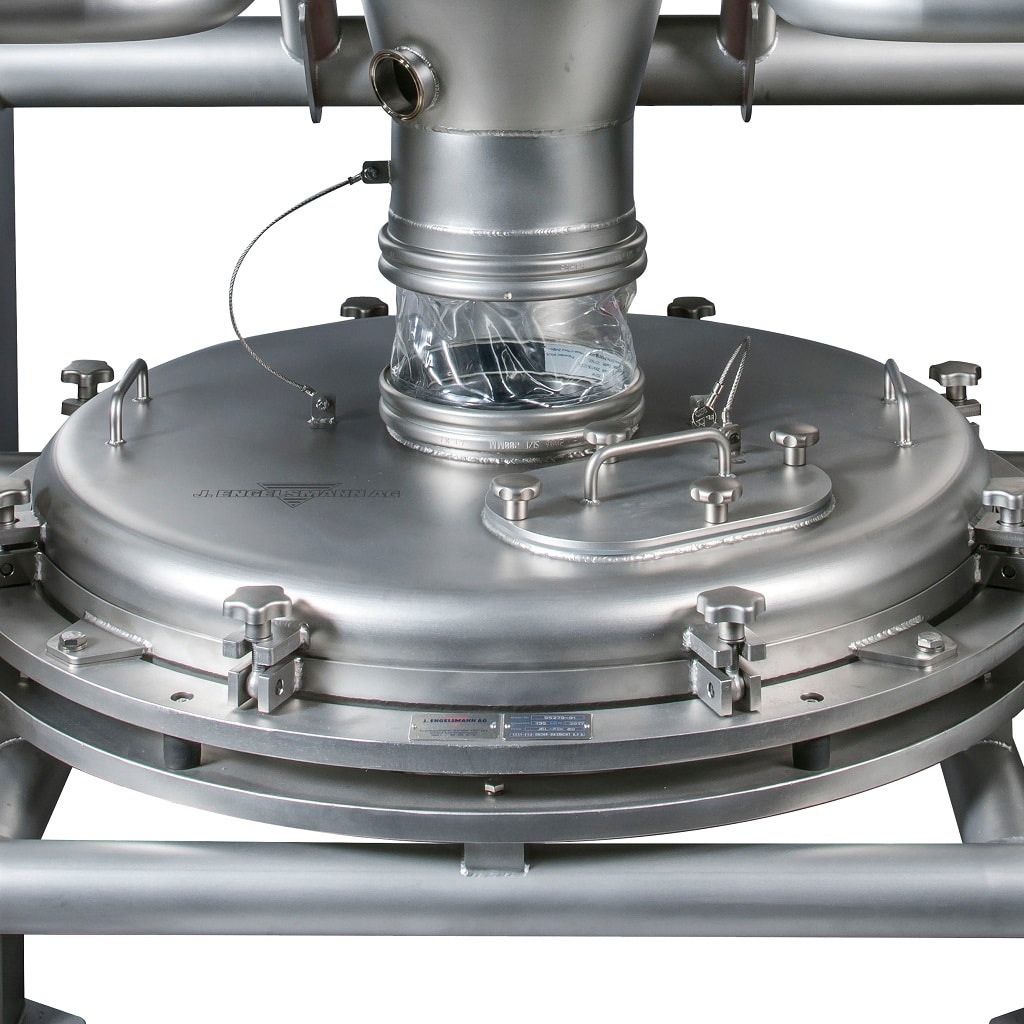
Protective screening solved in a space-saving way: the JEL Fix II vibration screening machine can also be retrofitted in existing plants.
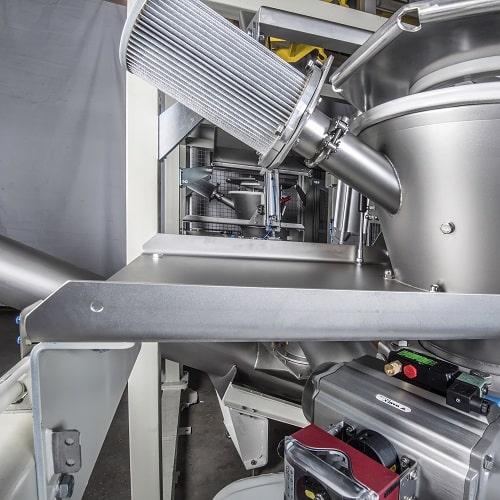
The dedusting and discharge of the lactose are ATEX-compliant.
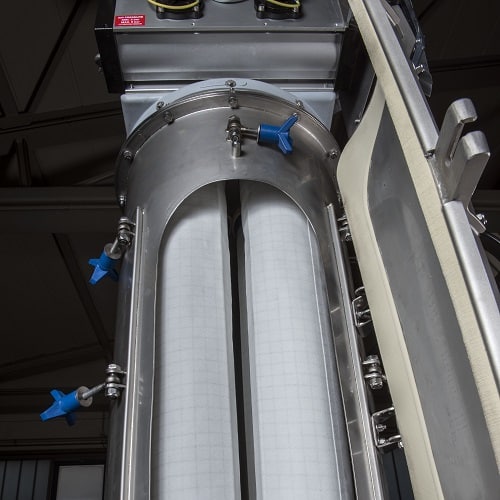
View into the filter system – like all components of the emptying station made of compliant materials.
On the cover of the protective sieve the connection for the attached dedusting filter with fan is located. When the product falls from the big bag onto the screen mesh, the filter extracts the dust-contaminated air in the screen. Product particles separated from the air stream by the bag filter elements are detached from the elements when the pneumatic filter cleaning is activated and returned to the protective sieve by using a pipe connection.
The transition piece to the on-site conveying elements is located under the screening machine.
Even the tying of the big bags after emptying is much more convenient for the operator thanks to the new filter unit. As long as the big bag is still connected, it is evacuated, i.e. the residual air is extracted together with any product residues. During the tying or folding process, dust formation is thus reduced to a minimum.
Safe, dust-free, hygienic.
The Big Bag emptying station is designed in accordance with the high hygiene requirements of the food industry and complies with the guidelines of the BfR – Bundesinstitut für Risikobewertung (Federal Institute for Risk Assessment) as well as the EU 1935/2004 regarding product contact materials.
All surfaces in contact with the product, such as the discharge hopper, are made of polished stainless steel. The design is free of dead spaces where product could get stuck and spoil despite thorough cleaning. Even areas not in contact with the product, such as the outer frame, are adapted to the hygienic production environment: Profiles made of round tubing and beveled roofs of the outer posts and control boxes prevent product residues or cleaning fluids from accumulating. Round rack profiles are also easier to clean than angular struts with straight contact surfaces.

